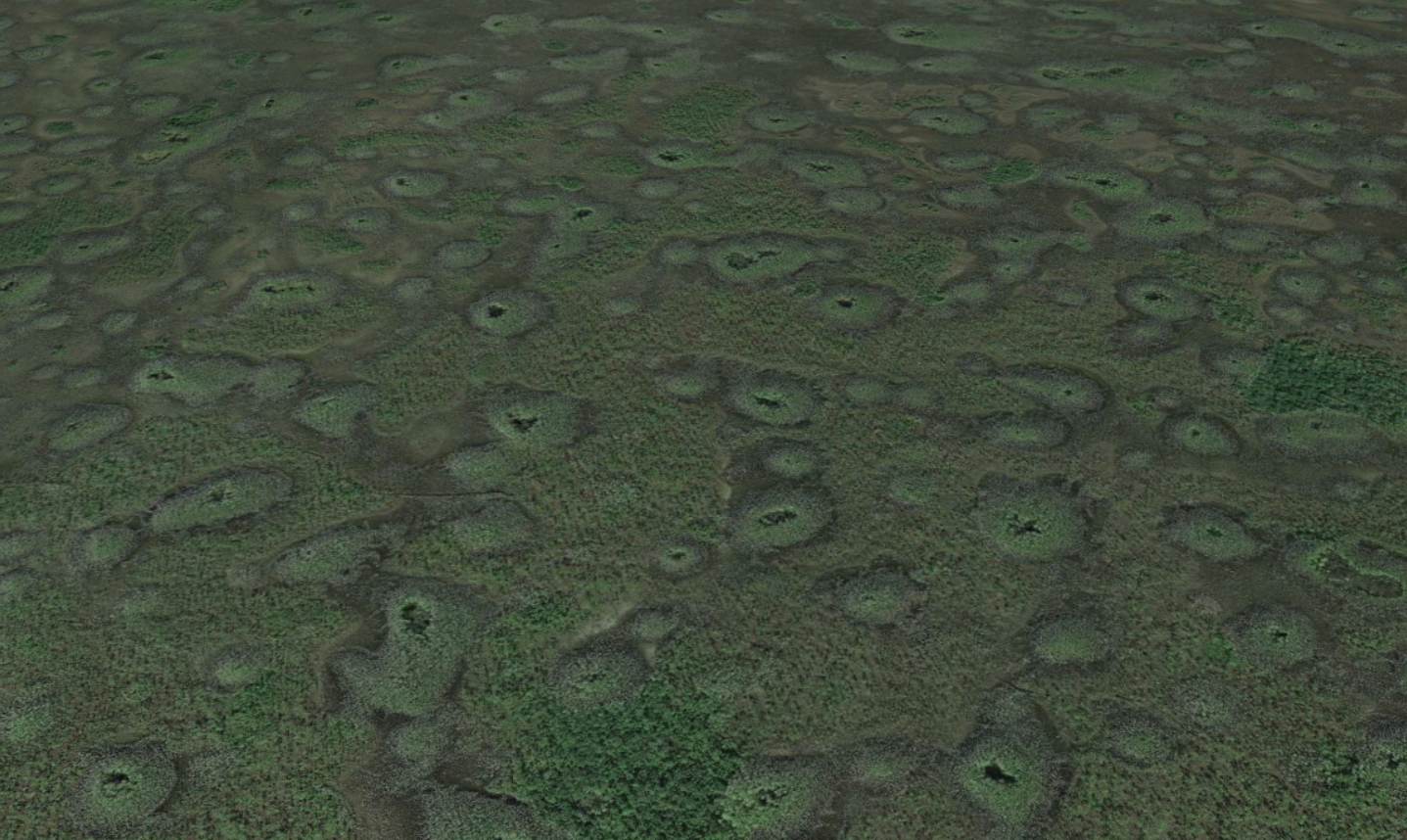Feature Image: Limestone depressions cover the landscape in the Big Cypress National Preserve in Florida, USA. (C) Google.
Article: Competition Among Limestone Depressions Leads to Self‐Organized Regular Patterning on a Flat Landscape
Authors: Dong, X., Murray, A. B., & Heffernan, J. B.
Patterns are abundant in nature, from evenly spaced termite mounds and vegetation patches to repeating series of ridges and valleys to sand dunes. The questions of why these patterns are so uniform and why they are found in disparate settings has been the subject of intense scientific interest over the last decades. Mathematical tools have given scientists the ability to study these “complex systems,” where behavior of the whole system emerges from interactions between smaller parts. While many different systems have been studied, recently researchers from the Duke University and the University of California at Davis investigated a patterned landscape with mysterious origins: the large, evenly spaced depressions in limestone bedrock that cover nearly 3000 square kilometers of the Big Cypress National Preserve in the Florida Everglades.
The main mechanism driving the evolution of this landscape is dissolution, where the limestone bedrock dissolves, or weathers, when it encounters slightly acidic water, usually from precipitation. Here, weathering produced depressions in the flat topography. These depressions are 120-160 meters wide and 2-2.5 meters deep and have thick soils that host the preserve’s cypress wetlands.
The trees themselves can speed the growth of the depressions, as living and decaying plants can make the water more acidic. In addition to rainwater directly entering the depressions, water can also enter via groundwater flowing through the limestone bedrock. The deeper the depression, the more likely it is to collect groundwater from the surrounding area. In the wettest times of the year, water overflows the depressions, connecting them and allowing the dissolved products of the limestone to wash away.
While previous studies revealed these mechanisms of evolution for individual depressions, it remained unclear why depressions should cover the landscape in such a regular, evenly spaced fashion. In order to understand this area’s complex history, the authors, led by Xiaoli Dong from Duke University’s Nicholas School of the Environment, modeled the evolution of these depressions across the landscape. By turning off and on different feedbacks, they could better understand what processes are necessary for the depressions to evolve into their present, regularly spaced pattern. Rather than just turning off or on every feedback, the team developed two alternative hypotheses: either scale-dependent feedbacks in space, or scale-dependent feedbacks in time are responsible for the regular patterns.
Scale dependent feedbacks in space are the combination of close-range factors that reinforce the growth of depressions and long-range factors that limit their growth. This combination is seen in many patterned ecological systems. For example, if a depression deepens, it can capture more groundwater, which causes it to weather and deepen further (short-range positive feedback). At the same time, deeper depressions reduce the ability of shallower depressions to capture groundwater and grow (long-range negative feedback).
In contrast, scale-dependent feedbacks in time have positive feedbacks early on, and negative feedbacks later in development. In early times, enlarging and deepening depressions capture more water and weather faster, while later on, depressions compete with each other for available area to grow into, and the increasing depth of water in deeper depressions can make it harder for plants to grow.
The authors found the time-dependent feedbacks are critical for the evolution of evenly spaced depressions they see at the Big Cypress Preserve. Competition between depressions for drainage area is the key factor that makes this landscape regularly patterned. The space-dependent feedbacks are not enough by themselves to create the pattern observed. In fact, space-dependent feedbacks alone might even produce a single large depression, with no regular pattern at all!
From these numerical experiments the authors have begun to understand more about how these depressions formed, while also generating ideas about how other, similar systems with interacting biologic and geomorphic forces may work. Dong and colleagues also emphasized the value of modeling like this for bridging gaps between how ecologists and geomorphologists think about complex systems. This kind of cross-pollination drives our understanding of the world around us forward.
Landscapes get depressed too: limestone depressions pattern a wetland landscape by David Litwin is licensed under a Creative Commons Attribution-ShareAlike 4.0 International License. Image is used under fair use guidelines.

